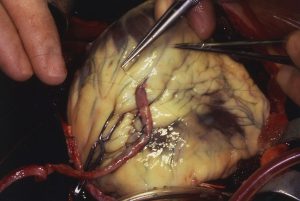Overview of CABG Trends in the United States

Despite an aging population and strong clinical evidence supporting the effectiveness and safety of the procedure, coronary artery bypass grafting (CABG) has declined by nearly 30% in the past decade in the United States. The decline of CABG has been accompanied by a corresponding increase in percutaneous coronary revascularization procedures.
These trends were reported in an article reviewing CABG surgery published in the May 19, 2016, issue of the New England Journal of Medicine.
The review was written by 2 Duke physicians: John H. Alexander, MD, cardiologist, vice chief of clinical research in the Division of Cardiology, and director of cardiovascular research at the Duke Clinical Research Institute and Peter K. Smith, MD, chief of cardiothoracic surgery.
Such overviews are published about every 10 years, Smith says. The previous CABG assessment was written by Cleveland Clinic authors.
“It was a terrific honor to be asked to objectively review the state of coronary bypass grafting in the treatment of the nation’s number 1 killer,” Smith says.
In the review, the authors emphasize a patient-centered approach that incorporates input from multiple physicians to make treatment recommendations for individual patients as well as the importance of secondary prevention directed by primary care physicians with patient-centered general medical practices. “We wanted to place CABG surgery in the context of all available treatment options in an evidence-based construct to inform all physicians,” says Smith.
The review also compares outcomes of CABG and percutaneous coronary intervention and discusses such complicating factors as diabetes mellitus, left ventricular dysfunction, and mitral valve disease, as well as acute coronary syndromes, including unstable angina and non–ST-segment elevation myocardial infarction.
The authors concluded that CABG offers significant improvement in survival rates and quality of life for appropriately selected patients with multivessel coronary artery disease. “Those with more advanced artery disease, left ventricular dysfunction, or diabetes are particularly likely to benefit from CABG,” Smith says.